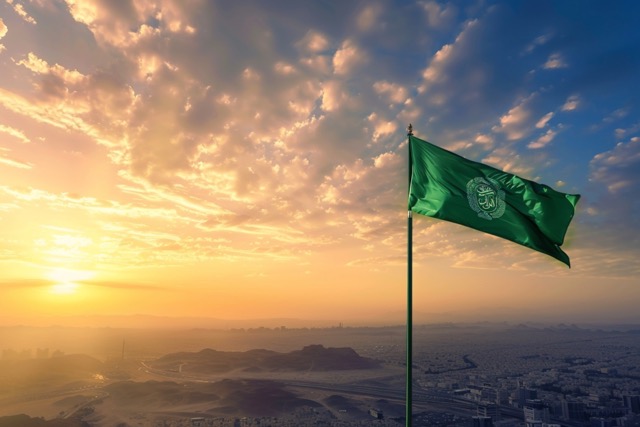The King Salman Royal Reserve: A Haven for Birds
JEDDAH: Nestled in the northern part of the Kingdom lies the King Salman bin Abdulaziz Royal Reserve, a recognized bird paradise by BirdLife International. Recent expansions have solidified its status as one of the world’s largest and most important bird regions.
Expansions to the reserve have added key areas such as At-Turaif, Harrat crater, Hail, and Tabarjal to the list of global bird sites within the reserve. These locations, strategically positioned on major bird migration routes, serve as crucial protection zones for avian species.
Within the vast expanse of the reserve, an impressive 290 species of wild birds have been documented. Of these, a staggering 88 percent are migratory, making a pit stop in the reserve, while 12 percent are permanent residents.
FASTFACTS
• 58 percent of the total birds recorded in all regions of the Kingdom find refuge within the King Salman Royal Reserve, underscoring its importance for avian conservation efforts.
• The additions to the global bird sites within the reserve include the At-Turaif area, Harrat crater, Hail area, and Tabarjal.
An astounding 58 percent of all bird species documented in the Kingdom seek shelter within the reserve, highlighting its critical role in avian conservation. Alarmingly, 25 of these species are classified as threatened on the Red List of Threatened Species.
A Jewel in the Crown
At the heart of the reserve lies Al-Khunfah Natural Reserve, spanning over 20,000 sq km on the fringes of the Nafud desert. Established as a natural reserve in 1987, Al-Khunfah boasts a stunning natural landscape characterized by sedimentary formations and sandstone, showcasing a spectrum of colors from dark brown to white, with hues of gray and light brown.
The biodiversity within Al-Khunfah is remarkable, hosting a plethora of fungal, animal, and plant species. Resident and migratory birds, including the houbara bustard and cranes, find solace here, alongside trees such as arfaj, athel, arta, talh, harmal, and lavender.
Fahd Al-Shawaier, director of communication and public relations at the King Salman bin Abdulaziz Royal Reserve Development Authority, shared with Arab News: “The diverse wildlife inhabiting the area is vast… Arabian oryx groups were recently reintroduced, and plans are in place to reintroduce species that were once present in the area.”
These endeavors aim to restore degraded ecosystems.
Al-Khunfah is not only home to avian marvels; it also hosts a range of reptile species, as well as rabbits and foxes. From the majestic Arabian wolf, sand cat, wild cat, and the false cobra to the elusive desert warbler, wild rabbit, and desert hedgehog, the reserve shelters a myriad of species.
NUMBER
A remarkable 290 species of wild birds have been recorded within the expansive boundaries of the King Salman Royal Reserve.
The area also hosts numerous resident bird species such as the Arabian partridge, greater hoopoe-lark, owl, and long-legged buzzard, as well as migratory birds like the steppe eagle, eastern imperial eagle, vulture, and saker falcon.
Al-Khunfah offers a variety of habitats for reptiles, including the desert warbler, lizard, frog-headed lizard, and fringed-toed lizard, among others.
Al-Shawaier mentioned that Al-Khunfah is inhabited by one rabbit species, the cape hare, and two fox species, the red fox, and Ruppell’s fox.
Al-Khunfah’s mountains and highlands showcase nature’s splendor across areas such as Bagheith, Al-Asmar, Anz, Abu Talihat, Dhaea, Al-Dhahakiya, and valleys like Al-Fater, Niyal, Al-Saileh, Al-Aqeelah, Abu Mataya, and Wadi Al-Mawrida. Seasonal rains, ranging from 50 to 100 mm, sustain the land, plants, trees, and wildlife habitats.
The reserve’s varied landscape, encompassing sandy and rocky environments, plains, mountain slopes, and dunes, offers habitats for both resident and migratory wildlife species.
While seasonal rains are vital for plant growth and diversity, floods resulting from these rains can pose challenges to certain plant species.
The rains work to rejuvenate soil fertility and enhance its composition, fostering an ideal environment for plant growth, including annual herbs that rely on the rains to complete their life cycle, as well as the flourishing of trees, shrubs, and perennial herbs during the rainy season, boosting plant diversity in the region, as noted by Al-Shawaier.
“However, it should be noted that floods resulting from these rains can negatively impact plants, especially those intolerant to prolonged water immersion,” he added.
Temporary basins are formed, providing water for resident and migratory wildlife as long as the basins last.
The reserve has implemented various programs, initiatives, and projects, including wildlife surveys, reintroduction programs, post-release monitoring, and initiatives to preserve vegetation cover and habitats. These efforts are crucial for achieving conservation goals and ensuring the long-term sustainability of this ecological sanctuary.

